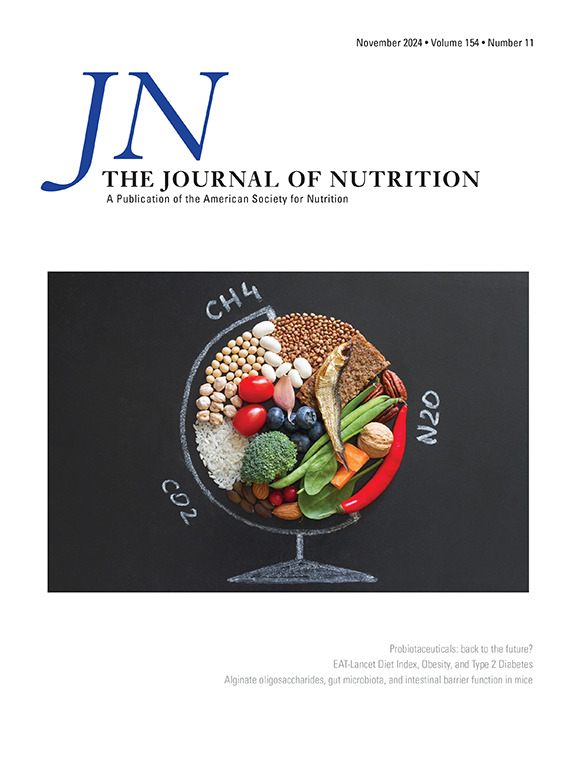中国地下水含碘量较高地区 3-13 岁儿童的碘营养状况。
IF 3.8
3区 医学
Q2 NUTRITION & DIETETICS
引用次数: 0
摘要
背景:充足的碘对儿童的健康和正常发育至关重要。然而,有关地下水含碘量高地区儿童碘状况的研究却很少:监测中国山东地区(主要为地下水碘含量高的地区)儿童的碘状况,并描述影响儿童碘状况的因素:从 2013 年到 2023 年,我们对 3253 名 3-13 岁的儿童进行了横断面研究。我们采集了儿童的饮用水、定点尿液和 24 小时尿液样本,评估他们的碘状况(测量饮用水碘浓度(WIC)、水碘摄入量(WII)、尿碘浓度(UIC)、24 小时尿碘排泄量(24-h UIE)、每日碘摄入量(DII)等),并分析了影响因素:儿童WIC的中位数为183(IQR:70.2,362)微克/升,UIC的中位数为428(IQR:194,737)微克/升,超过了世界卫生组织的临界值(300微克/升)。有碘超标风险的儿童有 1750 人(61.8%)。约 61% 的碘摄入量来自饮用水。男孩的碘摄入量明显高于女孩(P < 0.001)。儿童的年龄与现场碘摄入量、24 小时碘摄入量和 24 小时碘摄入量呈正相关。不同体重指数儿童的 24 小时 UIC 和 24 小时 UIE 没有明显差异。逻辑回归模型显示,男孩性别、年龄增加(OR = 1.05,95% CI:1.02,1.08)、WII 每增加 10 μg(OR = 1.04,95% CI:1.03,1.04)或 50 μg(OR = 1.19,95% CI:1.16,1.22),碘超标风险增加:结论:地下水碘含量高的地区的儿童有碘超标的风险。随着年龄的增长,儿童碘超标的风险也会上升,男孩的风险高于女孩。本文章由计算机程序翻译,如有差异,请以英文原文为准。
Iodine Nutrition Status of Children Aged 3–13 Years in Areas with High Groundwater Iodine Content in China
Background
Adequate iodine status is crucial for children's health and normal development. However, there is a paucity of research on the iodine status of children from areas with high groundwater iodine content.
Objectives
The objectives of this were to monitor the iodine status of children in Shandong, China (regions primarily characterized by high iodine concentrations in groundwater) and describe the factors influencing children's iodine status.
Methods
A cross-sectional study was conducted from 2013 to 2023 on 3253 3- to 13-y-old children. We collected drinking water, spot urine, and 24-h urine samples from children to assess their iodine status [measuring drinking water iodine concentration (WIC), water iodine intake (WII), urine iodine concentration (UIC), 24-h urine iodine excretion (24-h UIE), daily iodine intake (DII), etc.], and analyzed influencing factors.
Results
The median WIC for children was 183 (IQR: 70.2, 362) μg/L, and the median spot UIC was 428 (IQR: 194, 737) μg/L, surpassing the WHO cutoff (300 μg/L). Children at risk of iodine excess numbered 1750 (61.8%). Approximately 61% of iodine intake came from drinking water. Boys had significantly higher iodine intake than girls (P < 0.001). Children's age showed positive correlations with spot UIC, 24-h UIC, and 24-h UIE. There were no significant differences in 24-h UIC and 24-h UIE among children with different BMIs. The logistic regression model revealed that the risk of iodine excess was increased by boy gender, increment in age (OR: 1.05; 95% CI: 1.02, 1.08), and every 10 μg (OR: 1.04; 95% CI: 1.03, 1.04) or 50 μg (OR: 1.19; 95% CI: 1.16, 1.22) increment in WII.
Conclusions
Children in areas with high groundwater iodine content are at a risk of iodine excess. As age increases, the risk of iodine excess in children rises, with boys at a higher risk than girls.
求助全文
通过发布文献求助,成功后即可免费获取论文全文。
去求助
来源期刊

Journal of Nutrition
医学-营养学
CiteScore
7.60
自引率
4.80%
发文量
260
审稿时长
39 days
期刊介绍:
The Journal of Nutrition (JN/J Nutr) publishes peer-reviewed original research papers covering all aspects of experimental nutrition in humans and other animal species; special articles such as reviews and biographies of prominent nutrition scientists; and issues, opinions, and commentaries on controversial issues in nutrition. Supplements are frequently published to provide extended discussion of topics of special interest.
 求助内容:
求助内容: 应助结果提醒方式:
应助结果提醒方式:


